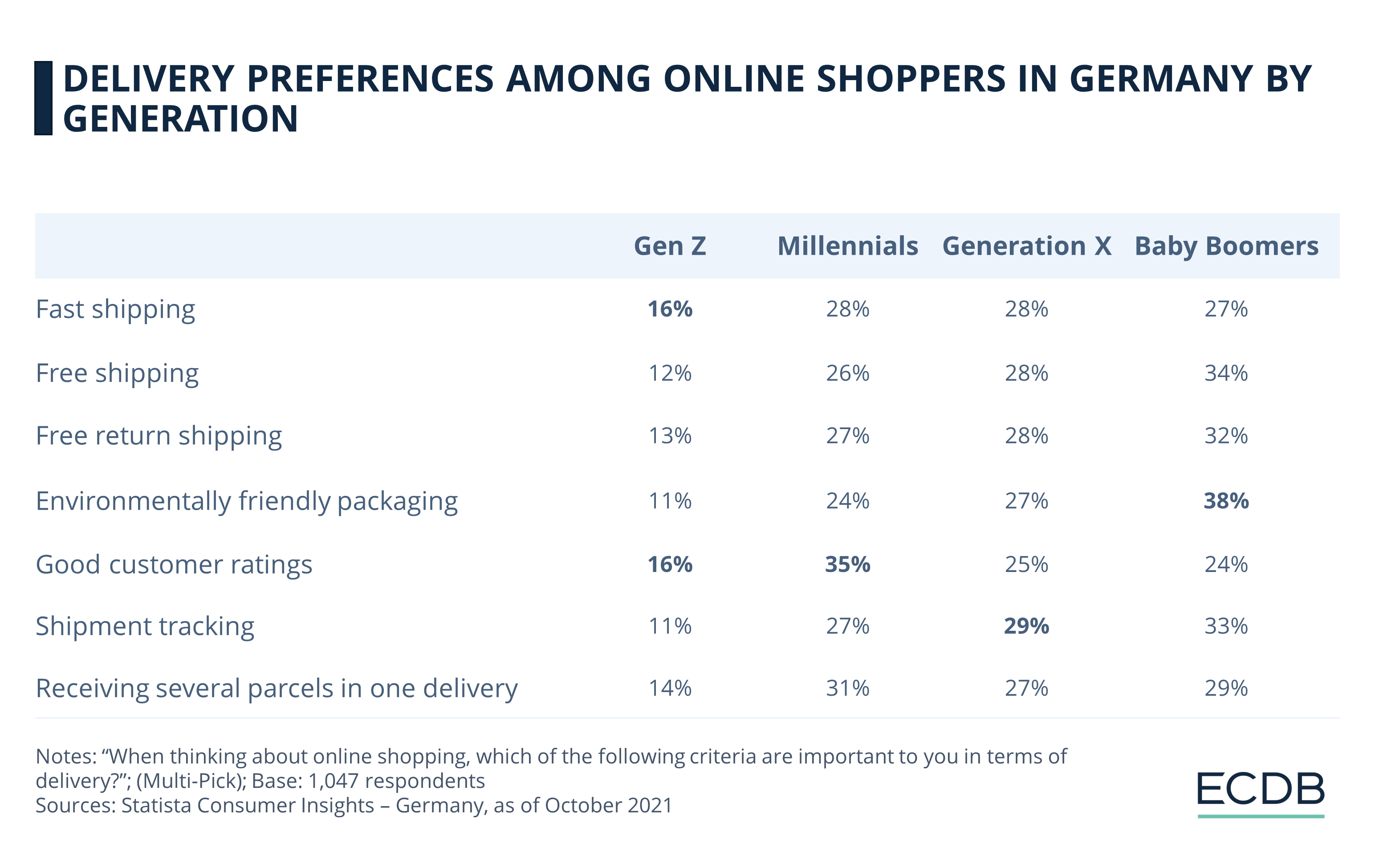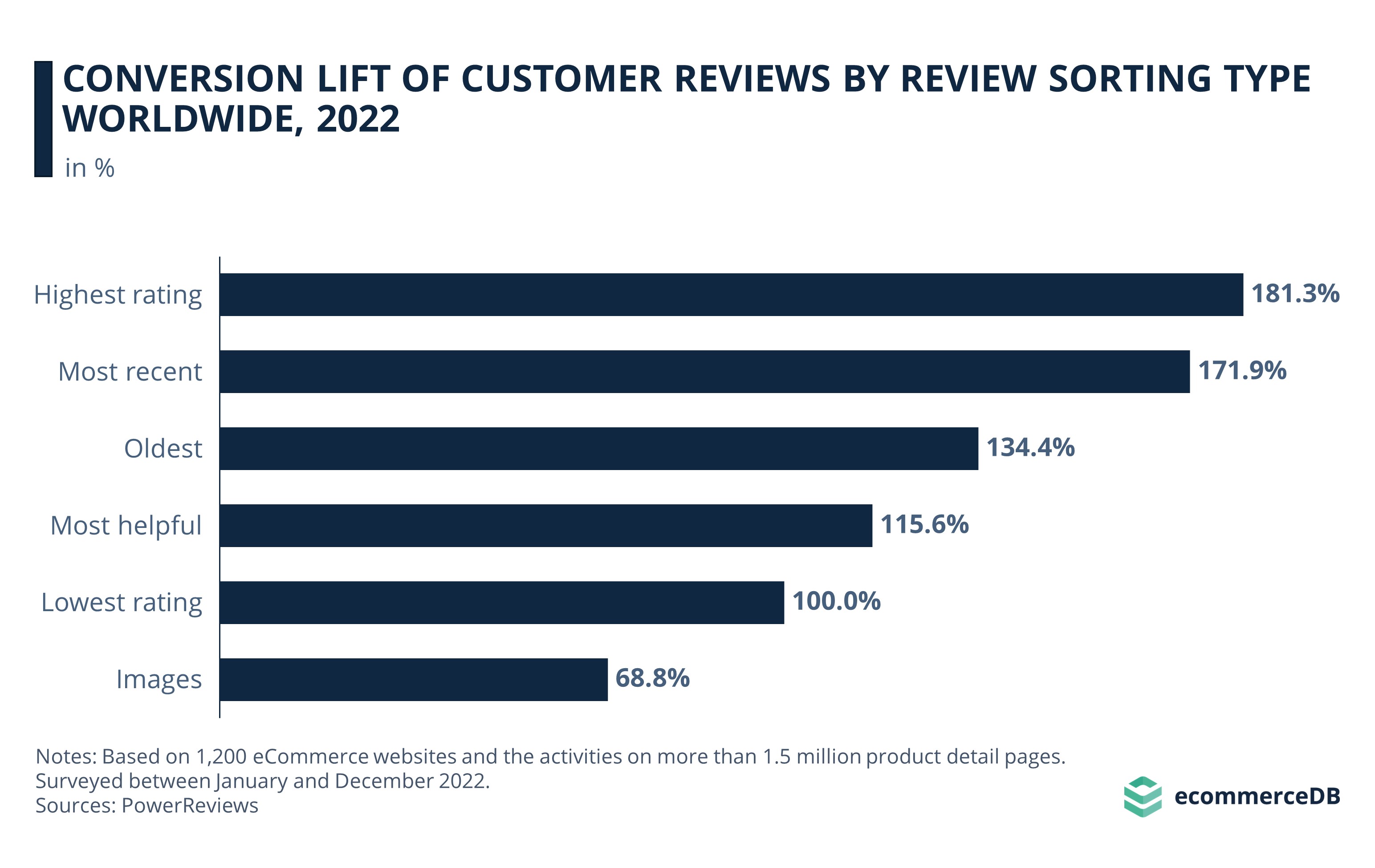Delivery Options: What Matters to Different Generations of German Shoppers?

The share of eCommerce in retail has increased in recent years, but the decision-making process at various touchpoints in the online shopping journey is nonetheless shaped by customers’ age. The generational cohort of an online shopper in Germany influences their delivery preferences, as a survey by Statista Consumer Insights underlines.
Responses from the survey participants show that not every aspect of delivery matters equally to every shopper.
Rather, there exists a correlation between shipping preferences and the shoppers’ age, with the greatest disparity occurring between the youngest and the oldest shoppers in most cases.
The older a shopper is, the more they desire convenient options like free shipping and shipment tracking. Alternatively, the youngest shoppers – Gen Z – are less opinionated about delivery criteria overall.

Older Generations Value Free Shipping and Tracking
Baby Boomers are the oldest participants in the survey, one out of four generational cohorts including Generation X, Millennials, and Gen Z.
They demonstrate strong opinions about delivery criteria: 34% of them prefer free shipping; 32% value free return shipping; and 33% want shipment tracking. Generations X (at 28%, 28%, and 29%) and Millennials (at 26%, 27%, and 27%) have comparable levels of inclination towards the same options.
In contrast, Gen Z’s responses deviate visibly, with only 12%, 13%, and 11% of shoppers from this generation choosing free shipping, return shipping, and shipment tracking respectively.
The reason for older shoppers preferring free shipping options may be that they draw parallels between online and offline shopping. Since they would not pay extra to collect or return products bought in brick-and-mortar stores, they do not want to spend more on receiving things they buy online either.
In comparison, younger shoppers grew up as eCommerce developed. For them, paying for shipping may be a more normalized practice - therefore, they do not worry about it as much.
Baby Boomers Opt for Sustainable Delivery
Consciousness toward sustainable delivery options – such as environmentally friendly packaging and CO2 neutral shipping – appears to deepen with customers’ age, with Baby Boomers preferring such options the most and Gen Z shoppers the least.
Compared to just 11% of Gen Z, the percentage of Millennials, Generation X, and Baby Boomers who value environmentally friendly packaging stands at 24%, 27%, and 38% respectively.
A similar pattern is observed for receiving several parcels in one delivery, with 13% of Gen Z, 28% of Millennials, 29% of Generation X, and 30% of Baby Boomers selecting this option. As can be seen, the share of Baby Boomers who prefer those options more than doubles in comparison to Gen Z.
Contrary to prevalent assumption, the older generations are more conscious about sustainability and recycling in general. According to DS Smith, older generations hold themselves accountable for recycling boxes more so than their younger counterparts. This awareness may well be shaping their stronger preference for sustainability in delivery as well.
Millennials Like Fast Shipping and Customer Ratings
Two categories – fast shipping and good customer ratings – yield different insights in terms of generational preference. Fast shipping is slightly more popular amongst Millennials (28%) and Generation X (28%) than Baby Boomers (27%). In contrast, only 16% of Gen Z value it.
Additionally, more Millennial shoppers (35%) than those from any other generation value good customer ratings when it comes to delivery criteria, suggesting they trust recommendations and reviews, which end up influencing their purchasing behavior.
In comparison to Millennials, the share of Gen Z shoppers who find customer ratings an important yardstick for delivery is less than half – only 16% – indicating that they do not place as much worth on testimonials as older online shoppers.
Data indicates that reviews and ratings influence online shopping decisions to a considerable degree. Products that have received the highest ratings from previous customers garner more attention from potentials buyers online.

However, there still exists a generational difference. Millennials, who grew up with social media, are comfortable writing reviews or recommending a product online after a good experience. They use reviews and ratings as a channel to voice their opinions; thus, they also turn to it before making a purchase decision.
On the other hand, Gen Z approach online shopping from a more independent standpoint where they prefer doing their own research rather than relying heavily on online reviews and ratings.
Delivery Preferences by Generation: Key Takeaways
Generational attitudes towards delivery vary widely in Germany, particularly when one compares the oldest and the youngest generation of shoppers.
Delivery options that are more convenient and sustainable will satisfy older online shoppers.
The preference for free shipping and free return shipping strengthens as the shopper's age increases, likely because they compare online shopping to offline shopping experiences where these options do not come at an added cost.
Sustainability in shipping is popular amongst older shoppers because they, in general, tend to be more conscious towards recycling as compared to their younger counterparts.
Customer reviews and ratings are preferred by Millennials who turn to online and social platforms not just to convey their experience with retailers and products, but also to get verified advices from previous buyers.
Gen Z, on the other hand, may view ratings and reviews with more caution, leading to their lack of reliance on it when shopping online.
The youngest generation of shoppers, Gen Z, appears flexible when it comes to delivery overall. However, they may have strong preferences for other touchpoints on the purchasing journey. When it comes to attracting them, an overfocus on delivery convenience may prove to be less effective for eCommerce businesses.

Click here for
more relevant insights from
our partner Mastercard.
Related insights
Deep Dive
Next Generation eCommerce: Key Trends Shaping the New Age of Online Retail
Next Generation eCommerce: Key Trends Shaping the New Age of Online Retail
Deep Dive
Google's AI Project Jarvis Could Change Online Shopping
Google's AI Project Jarvis Could Change Online Shopping
Deep Dive
The Customer Journey in Online Shopping: It Begins with Search Engines
The Customer Journey in Online Shopping: It Begins with Search Engines
Deep Dive
TikTok Shop Expands Operation in the United States
TikTok Shop Expands Operation in the United States
Deep Dive
Fast Fashion Online Market: Fast Fashion Is Not Fair Fashion
Fast Fashion Online Market: Fast Fashion Is Not Fair Fashion
Back to main topics